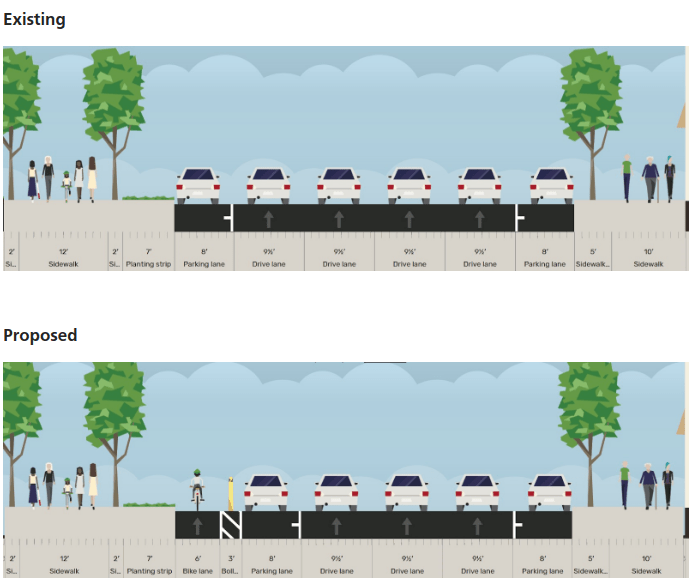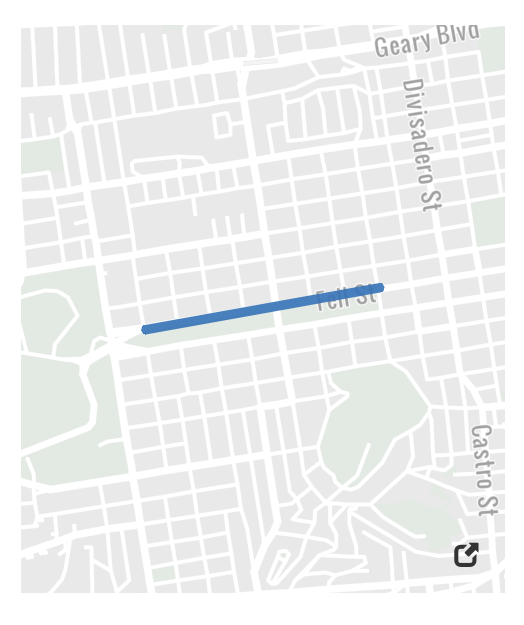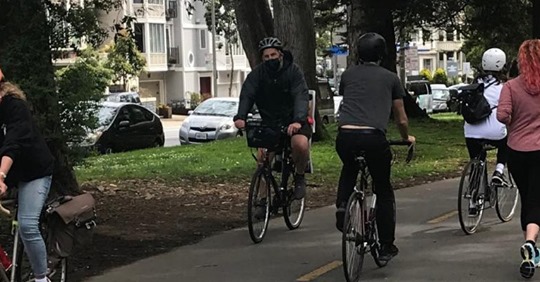Note: GJEL Accident Attorneys regularly sponsors coverage on Streetsblog San Francisco and Streetsblog California. Unless noted in the story, GJEL Accident Attorneys is not consulted for the content or editorial direction of the sponsored content.
SFMTA is planning to add something advocates have long sought on Fell Street--a protected bike lane along the Panhandle. This is in response to overcrowding on the Panhandle bike path, as seen in the lead image.
"The parking-protected bikeway will be on Fell Street between Baker Street and Shrader Street to provide relief to crowding and support social distancing on the Panhandle Path," according to a statement from Supervisor Dean Preston, whose district encompasses this portion of Fell. "The protected bike lane will reduce car travel lanes from four to three while simultaneously preserving nearly all the parking except for a handful of spots for visibility at intersections."
The new configuration, to be quickly built with paint and plastic posts, will begin construction next month.

"We're excited over here to see this temporary project announced. As you know, it's been designed for quick implementation to respond to urgent social distancing needs. Like any project, we expect there to be opportunity for conversation and feedback with the community and we expect this intersection to be one of the things SFMTA will want feedback on," wrote the San Francisco Bicycle Coalition's Rachel Dearborn in an email to Streetsblog. "Right now, the focus is on social distancing and alleviating urgent needs."
OK folks, this is BIG news. This is a critical step toward relieving congestion along the Panhandle pathway and making it safer for people walking and on bikes. This plan offers an opportunity to test out solutions to hopefully inform a longer-term design!
— SF Bicycle Coalition (@sfbike) May 19, 2020
More details from SFMTA: approximately twelve of the 136 parking spaces on the south side of Fell Street will be removed in order to provide space for turning lanes and visibility zones.

This is great news. However, in Streetsblog's view, a higher priority should be given to the busy intersection with Masonic. Streetsblog NYC addressed why mixing zones don't work--especially with left-side bike lanes (it's also worth noting that Dutch traffic engineers have rejected left-hand-running bike lanes, but obviously that would require serious retrofitting on Fell now because it needs to interact with the protected bike lane east of Baker).

Here's a tweet lifted from the Streetsblog New York article, which also includes information from NY DOT about improved treatments:
Engineers at SFMTA, however, disagreed with the comparison to the NYC design and issued the following reply:
In the case of the Fell Street bikeway, a mixing zone design with a separated bikeway (which differs from the NYC design in the Streetsblog posting) was chosen over a signal separated design or a “bend out” design (sometimes called a “protected intersection” – see below) for the following reasons:
- A reasonably good signal modification is not possible given the poles and mast arms that are in place. A poor signal design that has signal heads far out of alignment with the lanes they control can lead to confusion and red light running.
- There is not enough lateral width to create a proper bend out design, which can lead to drivers turning suddenly in front of cyclists going straight.
The “mixing zone” design planned differs from the NYC design in some key ways:
- It guides cyclists to a more visible spot before drivers can cross the bikeway, making it clearer that cyclists have the right of way over turning drivers
- The weaving area where turning drivers are to cross is designed for a low speed turn by drivers
- After the clearly marked weaving area, the bike lane will be surrounded by posts and will no longer be mixed with drivers
"We’d also flag that this is an emergency project in response to the pandemic, so a reasonably good signal modification isn’t possible within the time frame of an emergency project," added SFMTA spokesperson Erica Kato.
However, Vignesh Swaminathan, a consultant who worked on San Jose's quick-build protected network, pointed out that they could build a protected turn without modifying the signals, if SFMTA eliminated the left-turn pocket from Fell onto Masonic. "A protected corner would work really well there." He also suggested SFMTA consider installing a curb cut on the intersection approach, so cyclists can transition to the Panhandle path if they want to (and, Streetsblog would add, as a way for cyclists to evade a left-turning motorist who isn't paying attention/respecting the bike path right of way in the mixing zone).
Either way, "I'm happy with the Masonic intersection treatment as it's way more crucial (and safe) to blanket the city with temporary protected bike lanes and slow streets than to spend limited staff hours on one perfect protected lane," wrote advocate and Streetsblog contributor Kyle Grochmal. "I don't think SFMTA had any perfect options for the Masonic intersection."
For more details, SFMTA has posted a PDF of the drawings of the treatment.





